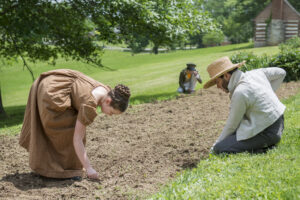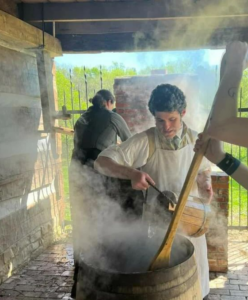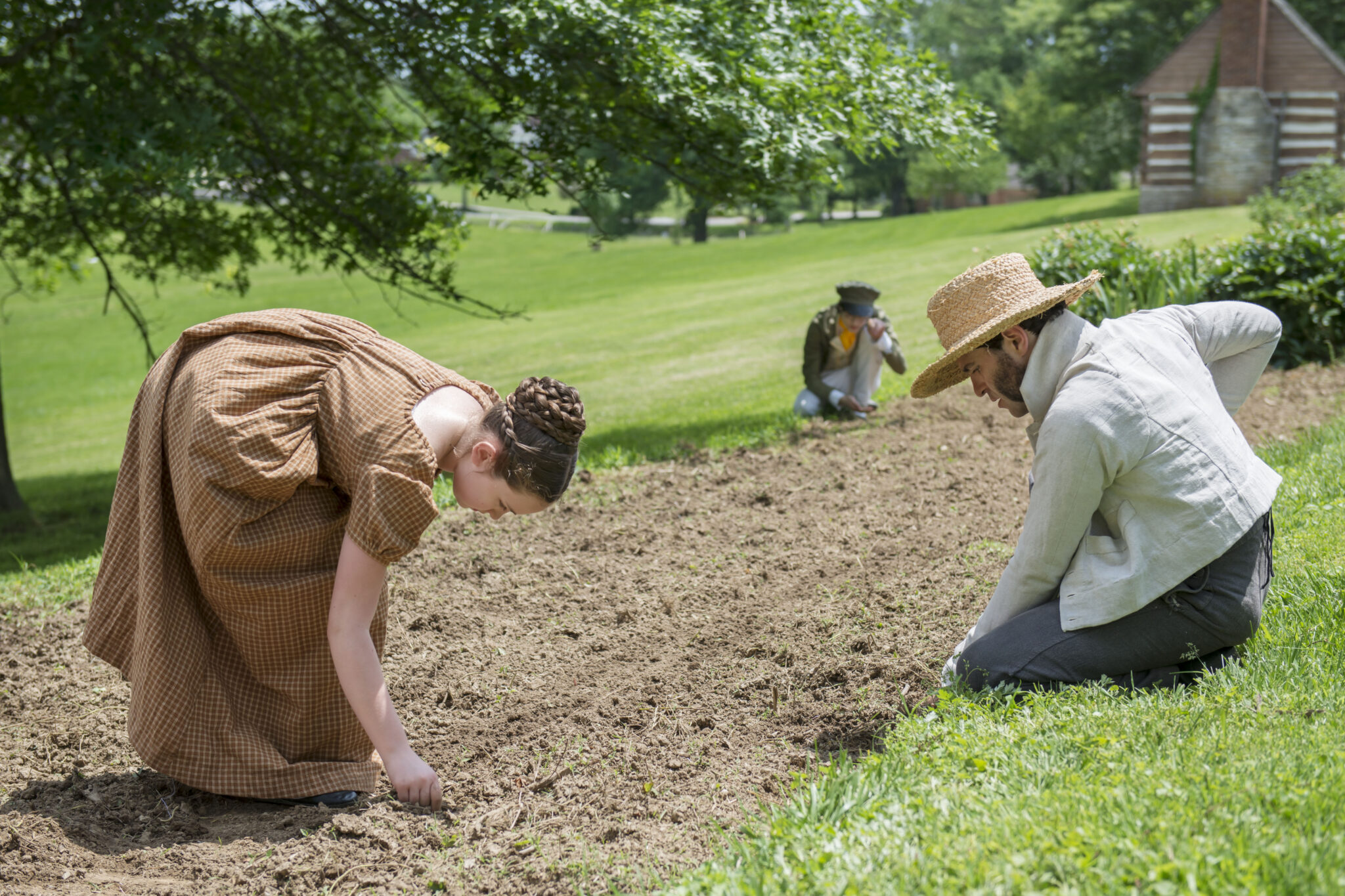Farm Distillery Project at Locust Grove Offers an Educational Glimpse Into the Past
Writer / Helen E. McKinney
Photography Provided
It’s been said that in Kentucky, whiskey is more than a drink – it’s a way of life. On Major William Croghan’s farm, it was used to preserve a product and make a profit – and yes, it was a way of life.
Croghan was the original owner of Locust Grove, a farm of 55 rolling acres just six miles upriver from downtown Louisville. He and his wife, Lucy Clark, a sister to General George Rogers Clark and William Clark of Lewis and Clark fame, built and lived in the 1792 Georgian mansion known now as the Locust Grove historic site.
In today’s world, visitors flock to such sites to take a peek at how whiskey was made and life was lived in the early 19th century. But in Croghan’s time, a distillery was used for crop processing and preservation so that grain and fruit crops would not spoil due to lack of refrigeration.
The Farm Distillery Project was born at Locust Grove to represent the small, farm-scale distilling activities of early Kentucky, before mass production evolved. Making whiskey from excess corn and other grains was one of the best ways to preserve the crop. At that time, Kentucky whiskey had not yet developed into the distinctive bourbon that we have today.
Once a distillery was recreated at Locust Grove in May 2017, historical interpreter Brian Cushing oversaw operations.“My main goal is for this to be an enticing window into the interconnected world of farm economy in the early 19th century,” Cushing says.
In 1999 Cushing began volunteering as a first-person interpreter at the historic site, portraying an individual relevant to the Locust Grove property in 1820.
Cushing says he “was fortunate enough to be the program director at the time the project started to come to fruition, and since I was already dealing with interpretive programming, including historic trades, I was tapped to dig into the specifics of how the distillery likely worked in the 19th century, and to translate that into action.”
This took a bit of researching. Cushing says he has always appreciated distilled spirits.
“I knew what they were and had a general idea of the history, but this went way further than that,” he says. “Melissa Alexander was a volunteer on the distillery committee and she made a connection with the distillery at George Washington’s Mount Vernon. To our delight, they invited us out.”
Cushing and others had the opportunity to spend three days making whiskey at Washington’s home in Virginia during full-scale production. “That was my first experience with getting my hands on the process and learning to make whiskey,” he says. “I always say I never had to break any modern habits. My introduction was the 18th century way.”
Steve Bashore and the crew at Mount Vernon were the cornerstone of his distillery training. Bashore is their master distiller and “that experience with him and his crew was formative for the direction my life took,” Cushing says.
To add to Cushing’s knowledge, he says Alan Bishop from Spirits of French Lick and One Piece at a Time Distilling Institute stepped in, and became a great friend and mentor.
“Wilderness Trail Distillery invited me to train with them for a day,” he says. “That’s where I got my best lesson in on-the-fly cooperage. I also went through Executive Bourbon Steward training at Distilled Spirits Epicenter and viewed every mention of distilled spirits that I could locate in the Filson Club collection from prior to 1900. Lots of other reading, discussing and experimenting followed.”
Records exist from Louisville’s Fitzhugh & Rose store to prove the purchase of a 66-gallon still on Croghan’s account in 1808. The original estate contained about 700 acres. The speculation is that Croghan operated a whiskey distillery on Muddy Fork, in what is now the Riverwood subdivision. It would have been the probable site for a mill, as very often, distilleries were associated with mills.
 Locust Grove got some of the biggest distilling families around on board for this project. Board Member Sally Van Winkle Campbell, the granddaughter of the legendary Pappy Van Winkle, “hit the ground and made it happen,” according to Cushing.
Locust Grove got some of the biggest distilling families around on board for this project. Board Member Sally Van Winkle Campbell, the granddaughter of the legendary Pappy Van Winkle, “hit the ground and made it happen,” according to Cushing.
“I doubt there was ever such a well-funded project at Locust Grove,” he says. “When I first heard about the idea, I thought that if it happened, I would probably be long-since retired, but she made those connections, stoked the fire of enthusiasm, and everybody came together as a team to see this thing through. It was amazing to watch unfold. I can’t thank her enough.”
Campbell says she had recently joined the Locust Grove board, and didn’t yet have a niche with which to be involved.
“One day back in 2014, I was meeting with our Director Carol Ely and she mentioned that there was evidence that there may have been a small-scale whiskey and brandy distillery at Locust Grove, and that there had from time to time been talk of recreating that,” Campbell says.
Being from a distillery family, Campbell immediately expressed interest.
“The thought just grabbed me,” she says. “To have the chance to tell the story of some of the first spirits produced in Kentucky, to tell a story of this farm that had never been told, it was just really exciting. Besides, the timing was right. It was 2014 and sprits production in the area was exploding. It was a perfect storm.”
“We were looking for ways to tell the farm story here, and farm distilling is part of the process of preserving crops,” Ely says. “A board member, Susan Reigler, who is a food and bourbon writer, mentioned that the Croghans would have distilled here, and the idea grew. Sally VanWinkle Campbell was key in fundraising for the refurbishment of an existing small log building to recreate a small farm distillery.”
Campbell admits she didn’t know a thing about fundraising. “It felt right to go first to the distillers in the area, and especially to Louisville’s historic distilling families,” she says.
That said, she visited a friend, Mac Brown, and said she needed help. His response was, “You’ve come to the right place!” She says they quickly raised $60,000 to jump-start the project.
There were other factors that helped get the project off the ground quickly. Campbell’s brother, Julian, and her family donated five bottles of Van Winkle bourbon, which raised funds through a national online auction.
“The other major reason the project took off so fast was because of all the in-kind donations,” Campbell says. “The Sherman family at Vendome Copper and Brass worked with us and made our beautiful and authentic little still.”
She also credits Dominick Pagano, and his vast background in engineering and passion for history. “He was responsible for drawing up plans, working with Vendome to get the still just right for us, laying old bricks, plumbing, shoveling dirt, digging drains, and having the wooden water raceway handcrafted,” she says.
“The project would never have had such a successful outcome without the passion, quest for knowledge, and creativity of Brian,” Campbell adds. “His enthusiasm for the project from the start was palpable.”
Ely says visitors to the distillery will remember the “skill and artisanry of the workers as they developed the process and adapted it for Kentucky crops, the sheer labor involved in doing by hand what is now done effortlessly by machines, and the context of distilling as a farm craft just like smoking meat or making cheese, drying and preserving fruit, or milling and baking.”
“The Croghan family enslaved approximately 100 individuals between 1790 and 1856,” Campbell says. “These enslaved men, women and children were the heart of the farm at Locust Grove and without them it would not exist. Because of the distillery, we are able to tell a deeper story, because it was the enslaved – and primarily the enslaved women – who were the distillers.”
For more information including tour details, please visit locustgrove.org.





